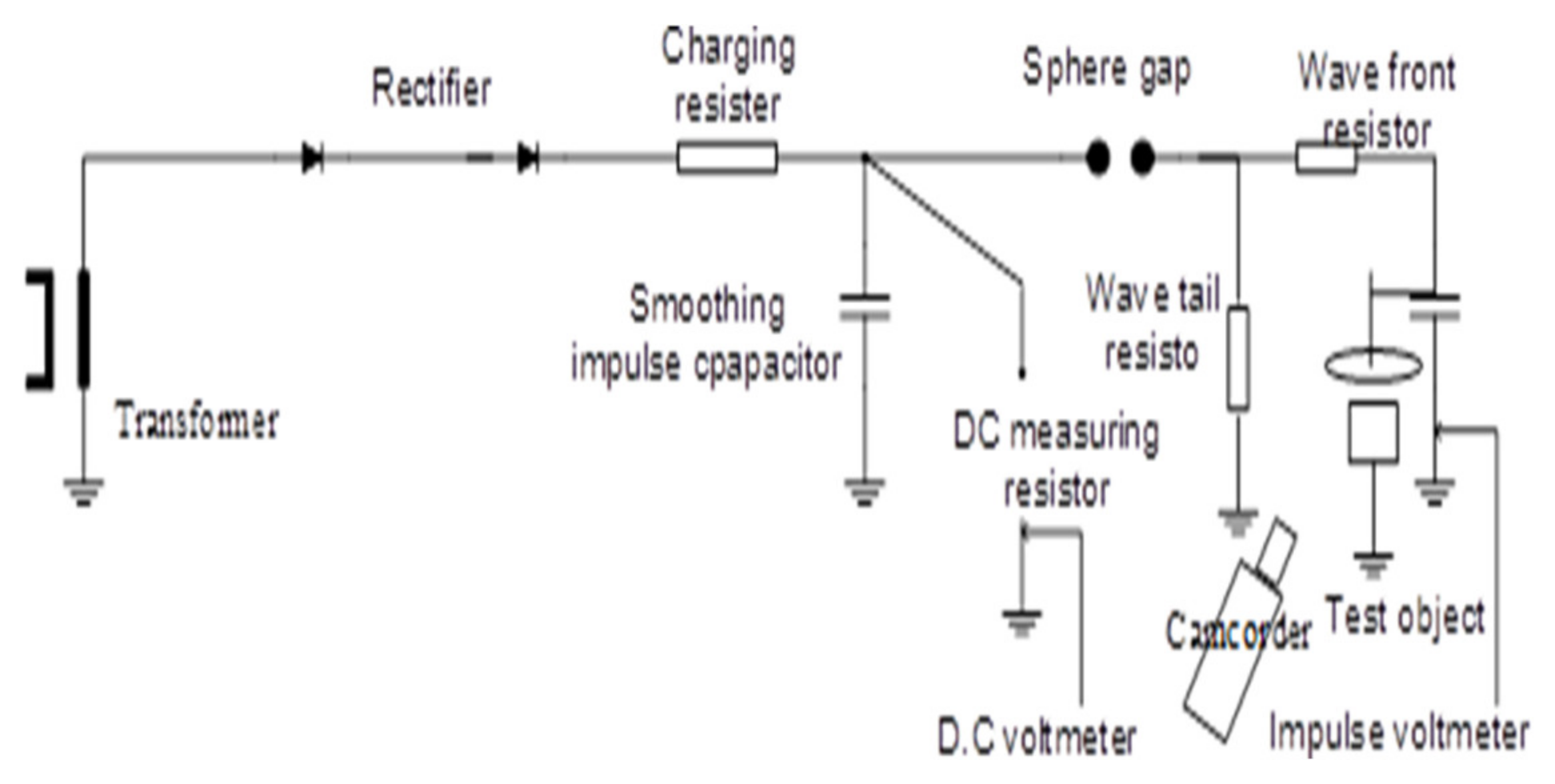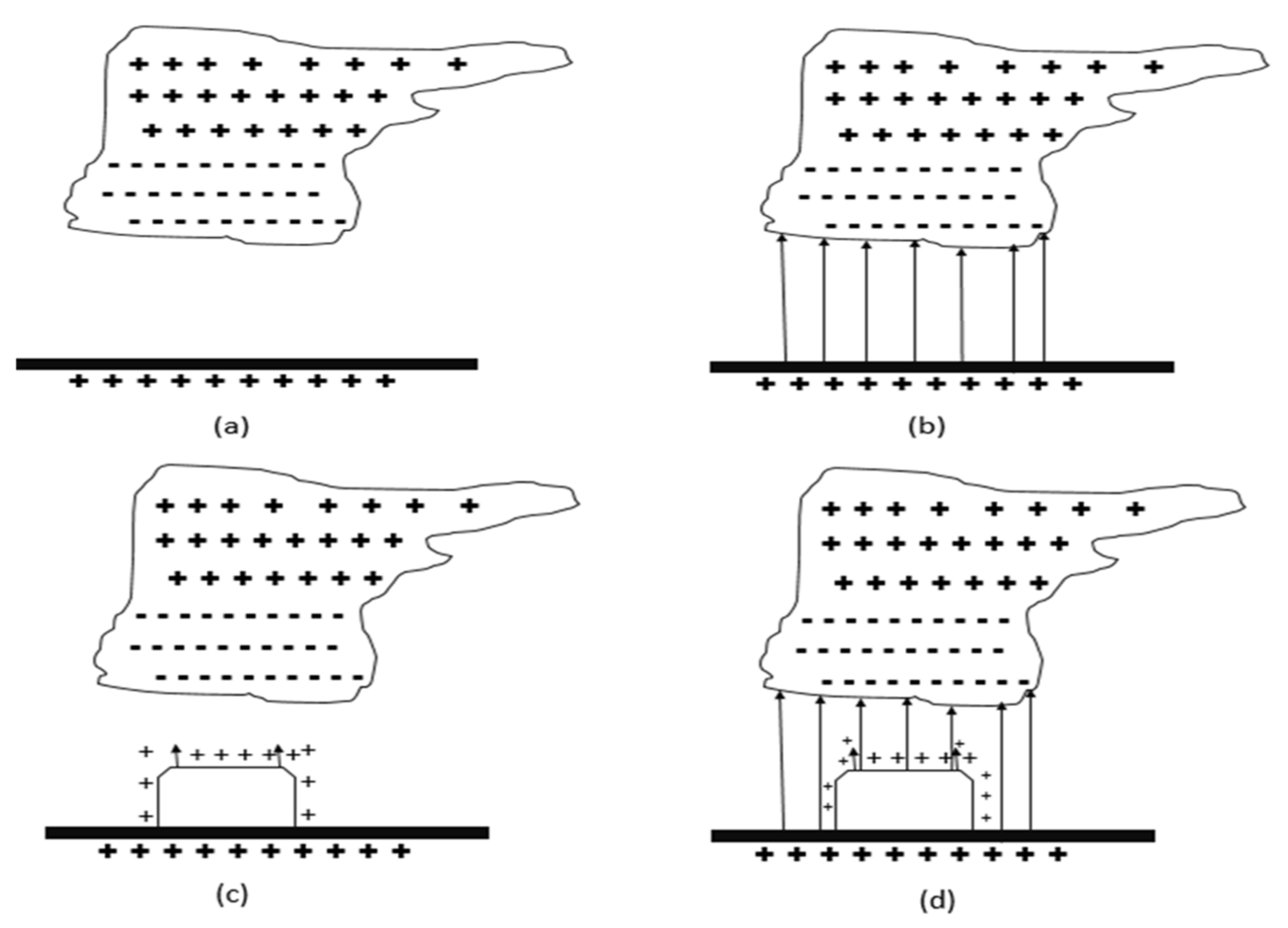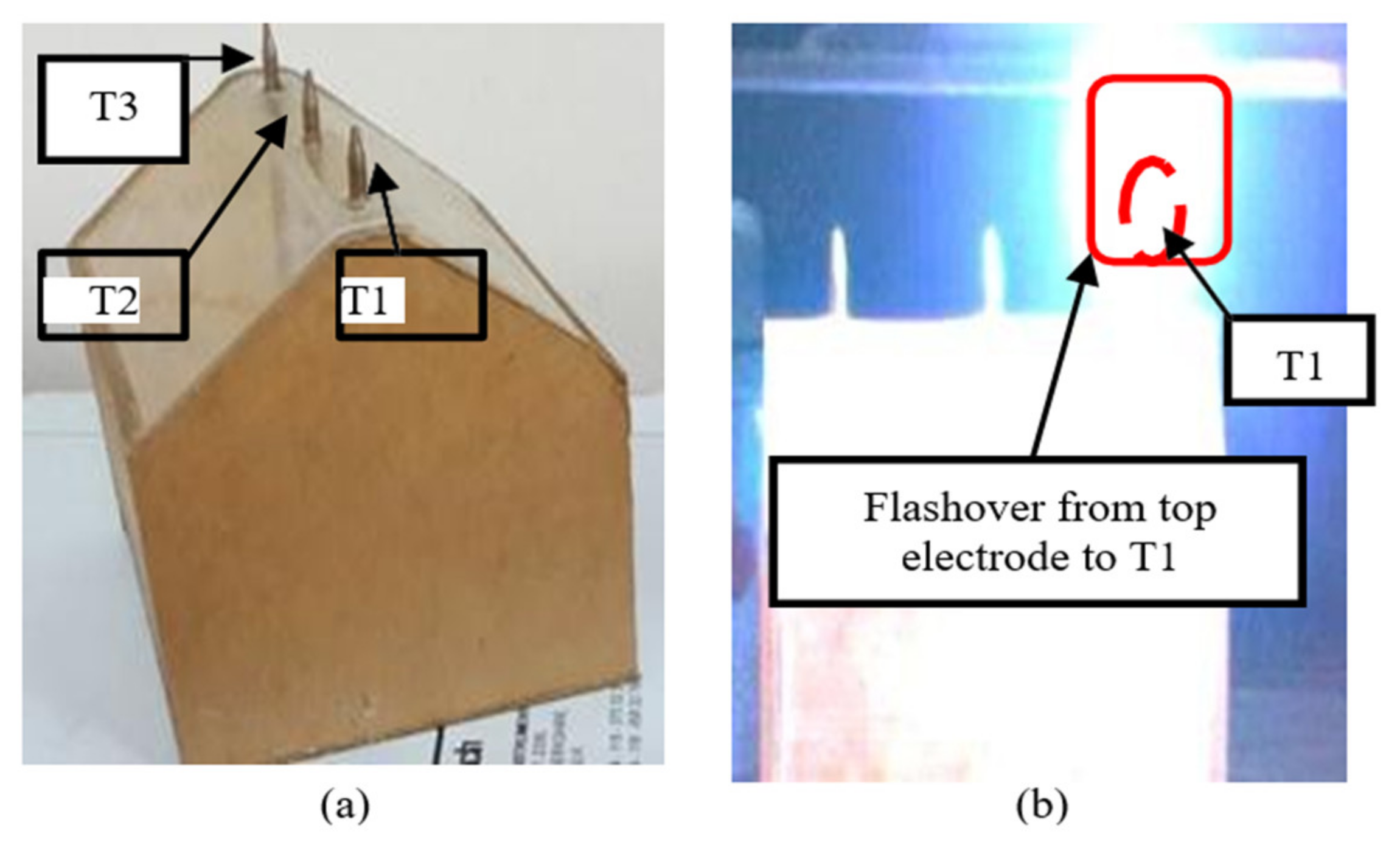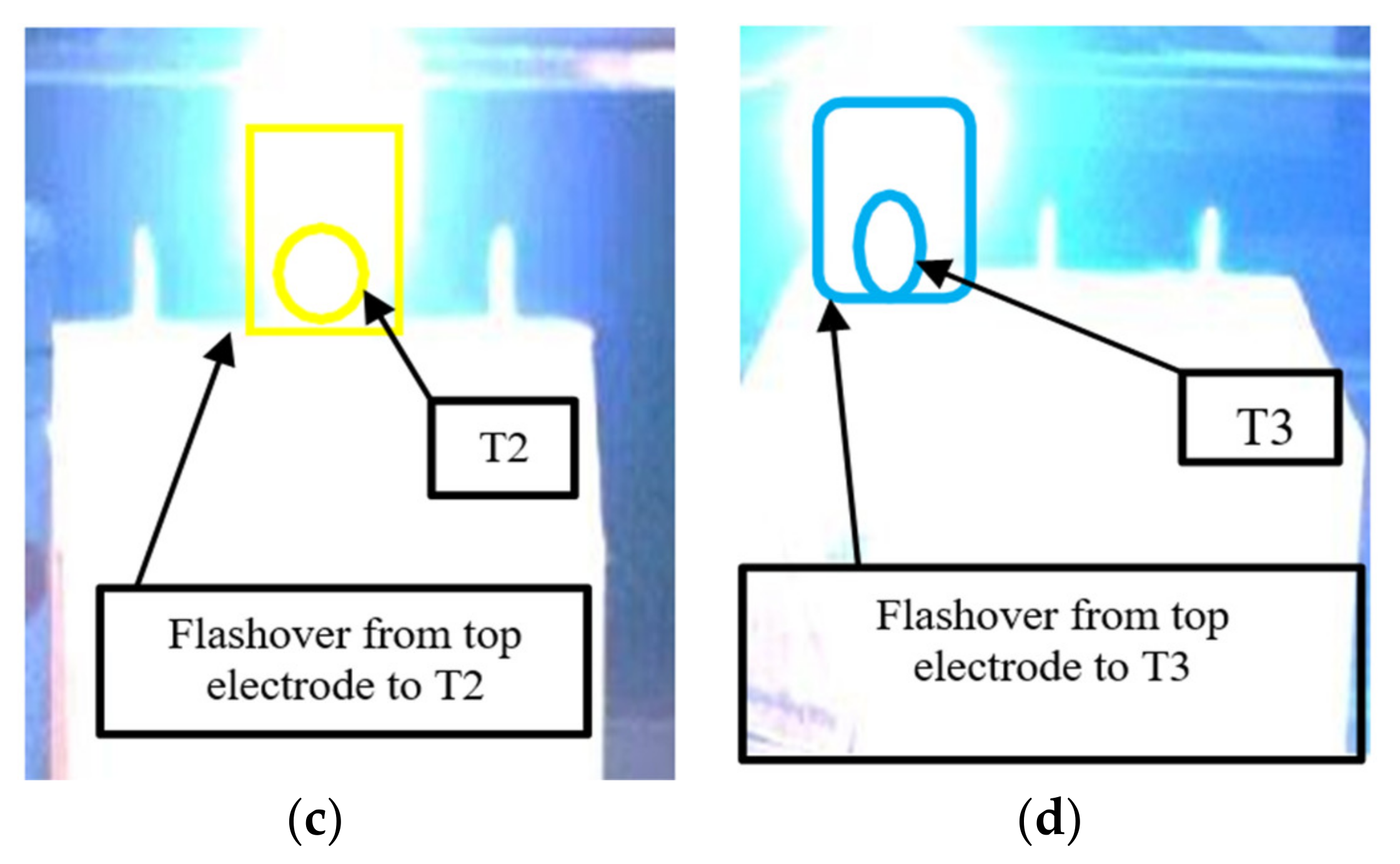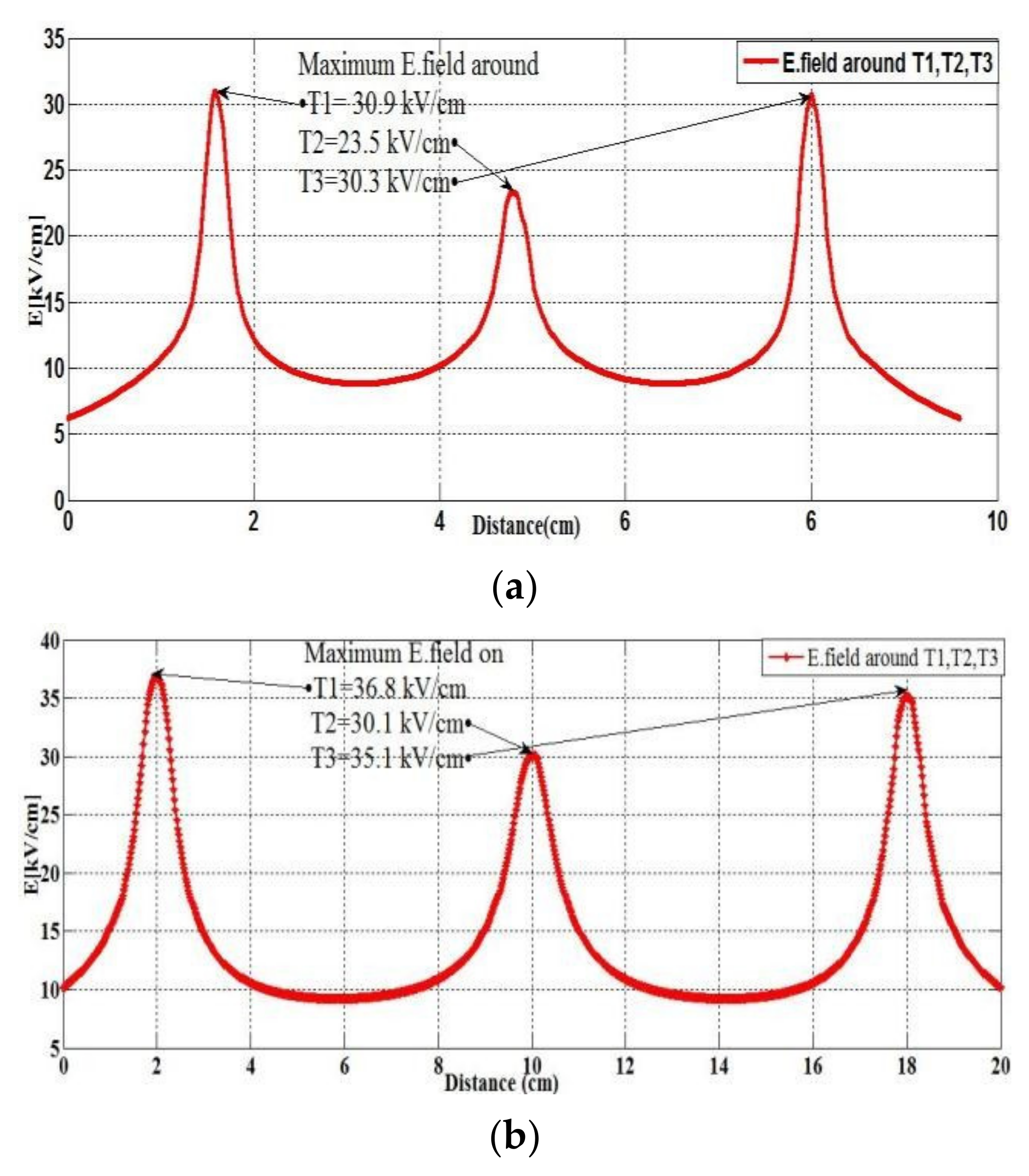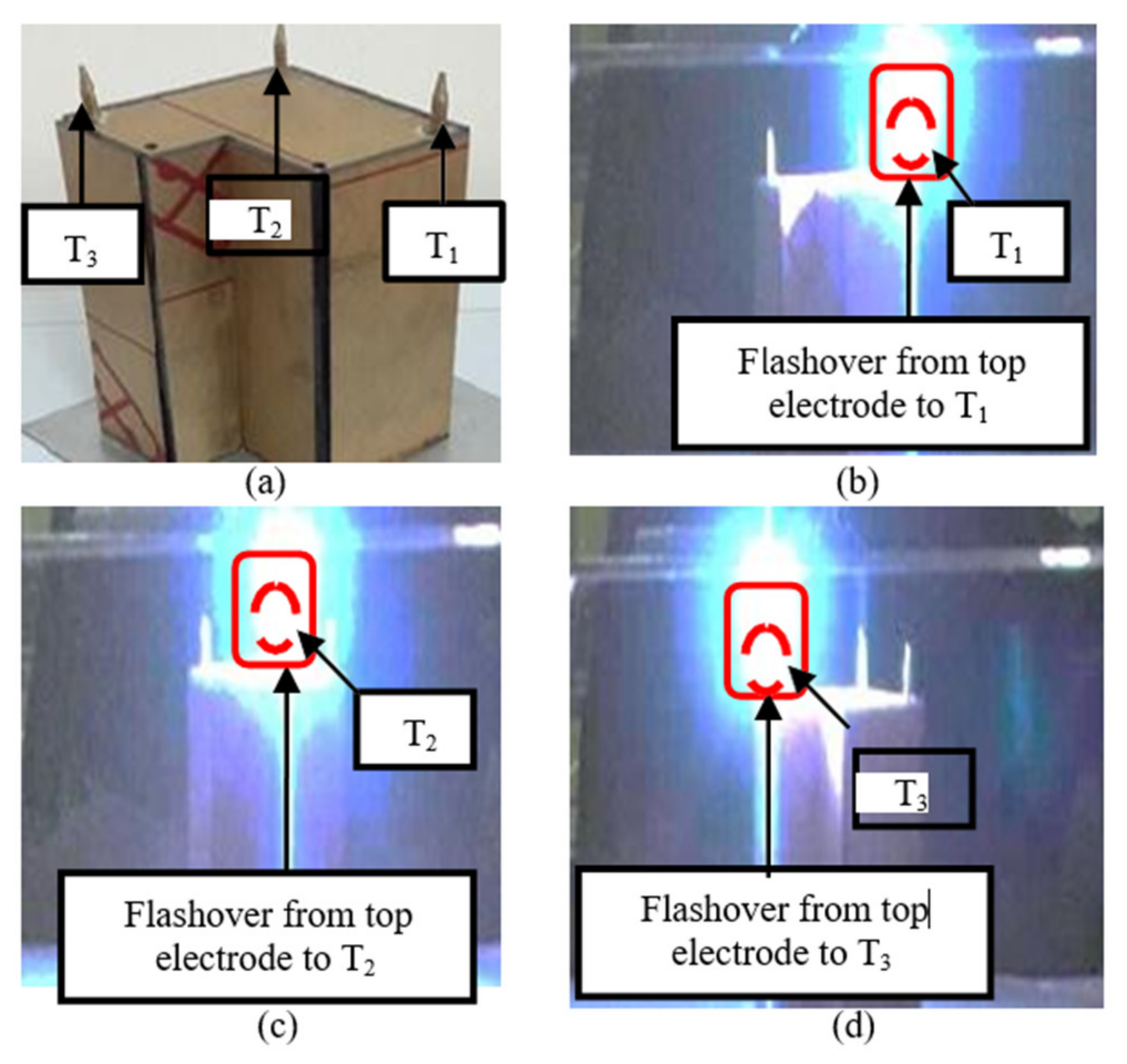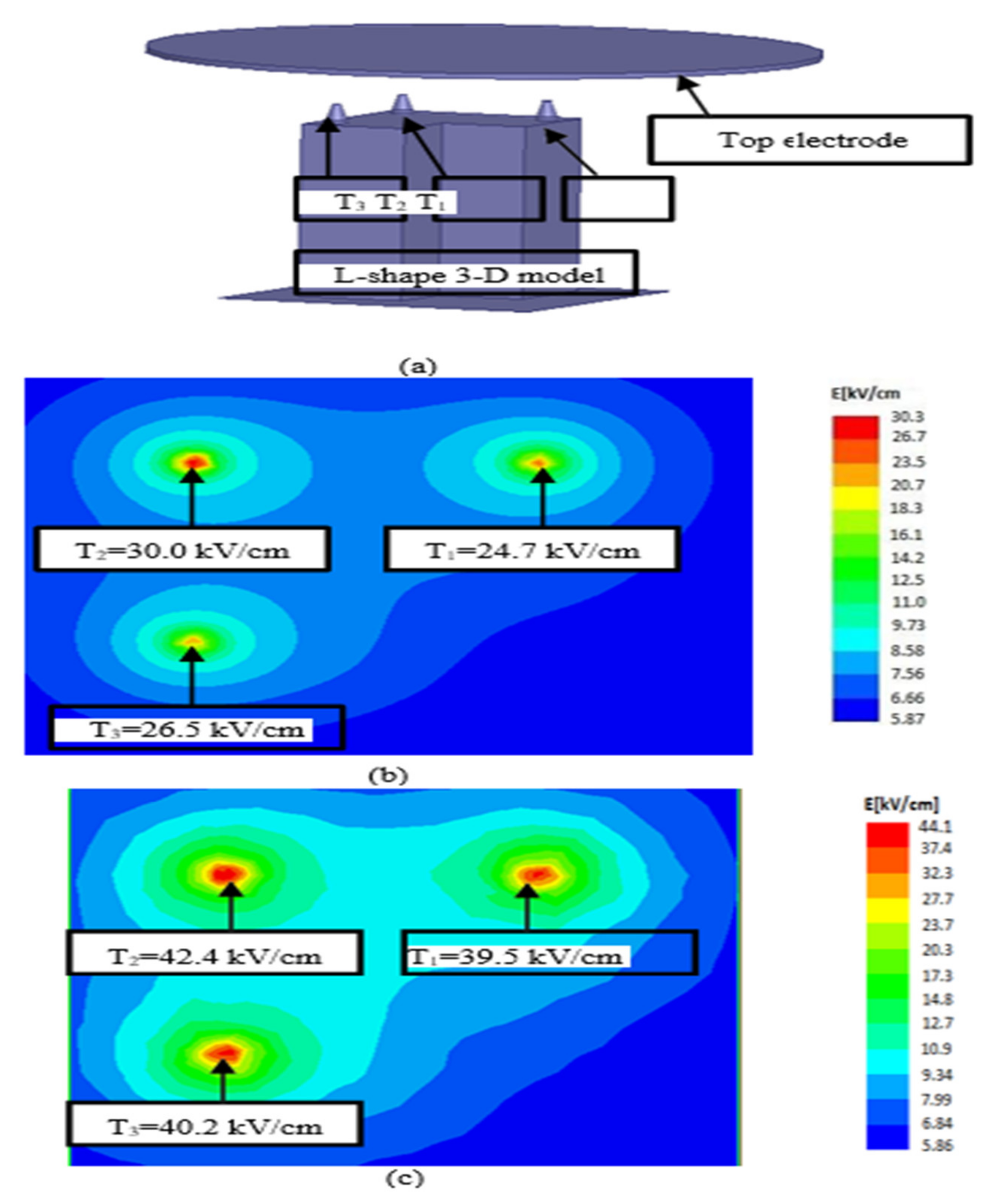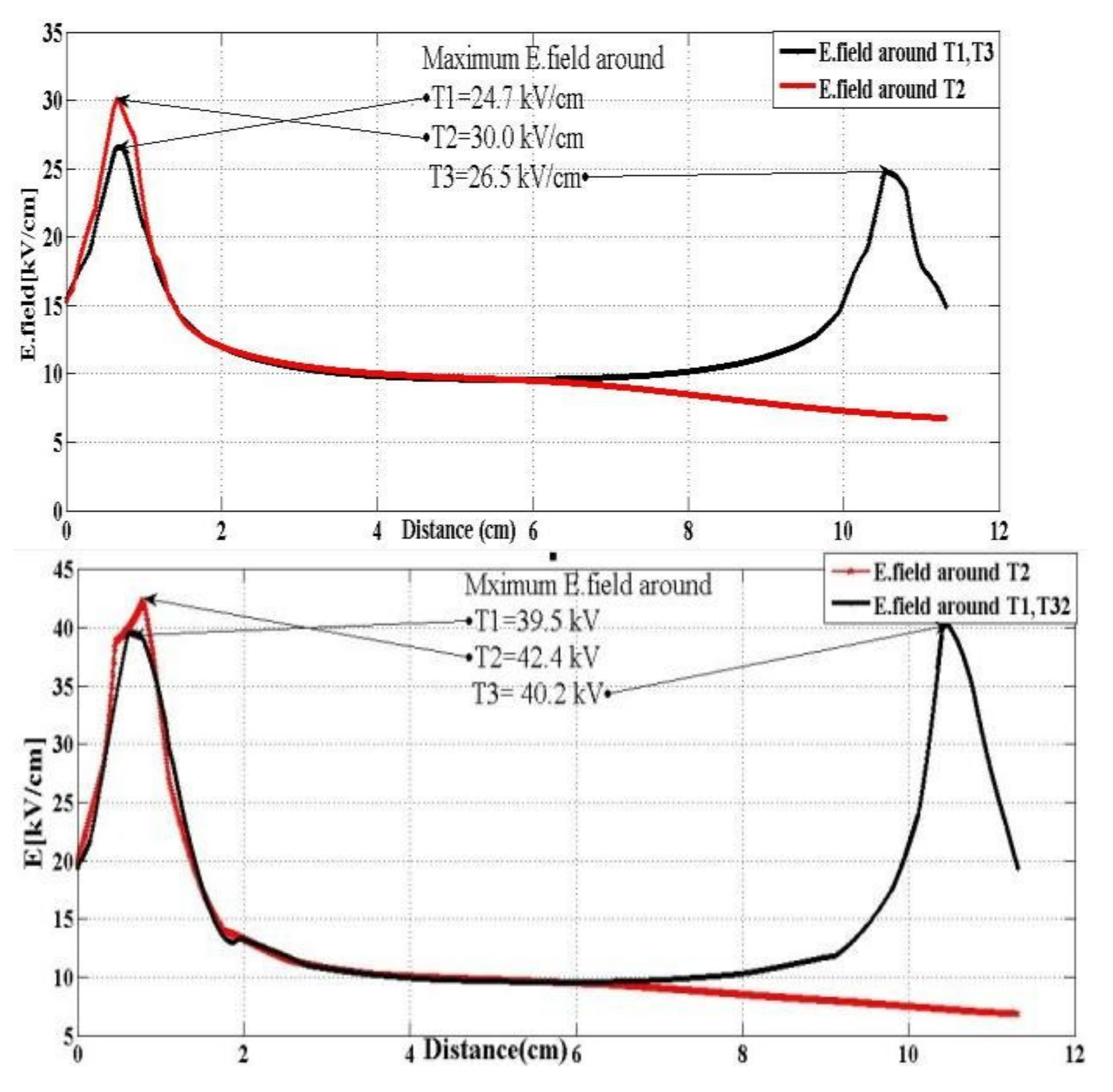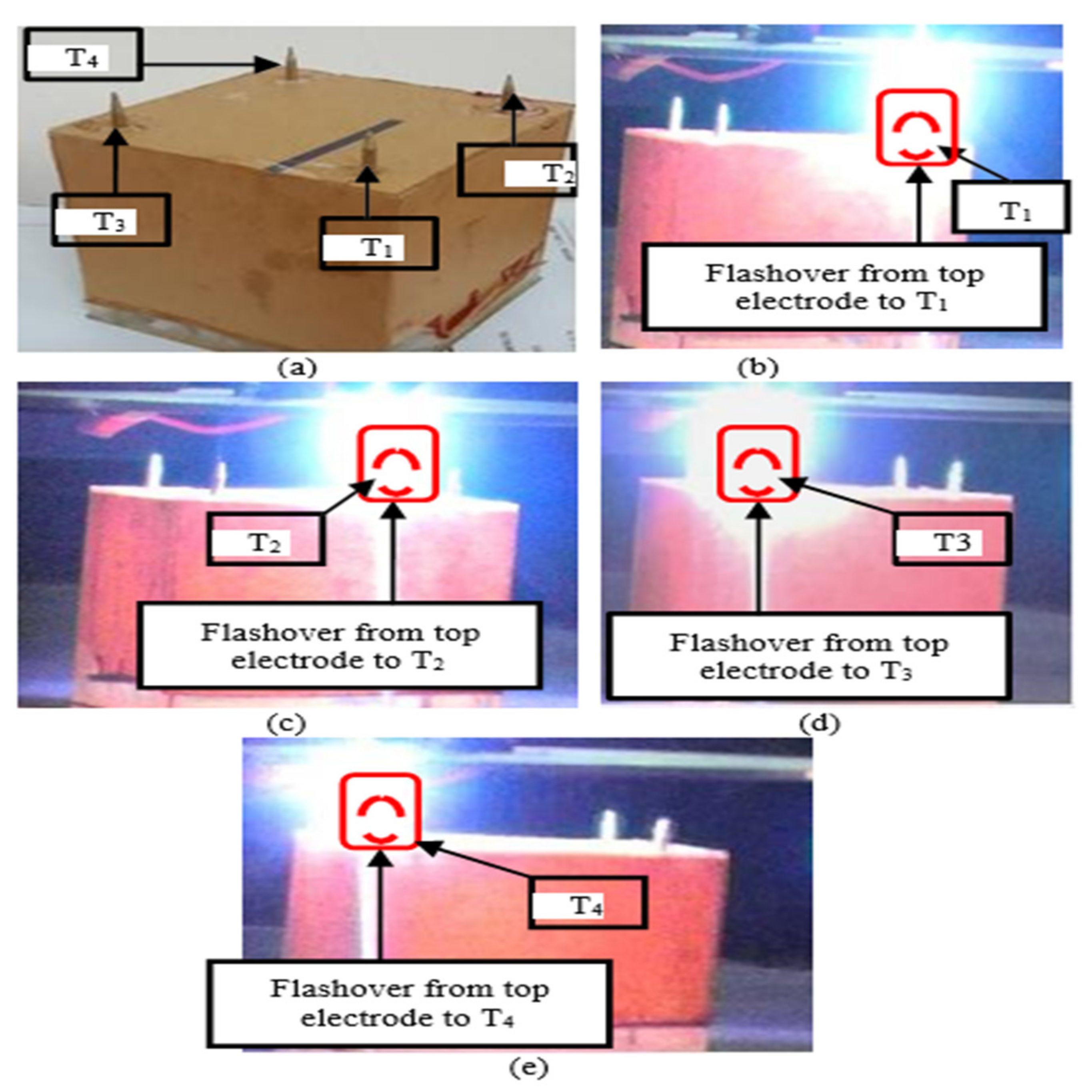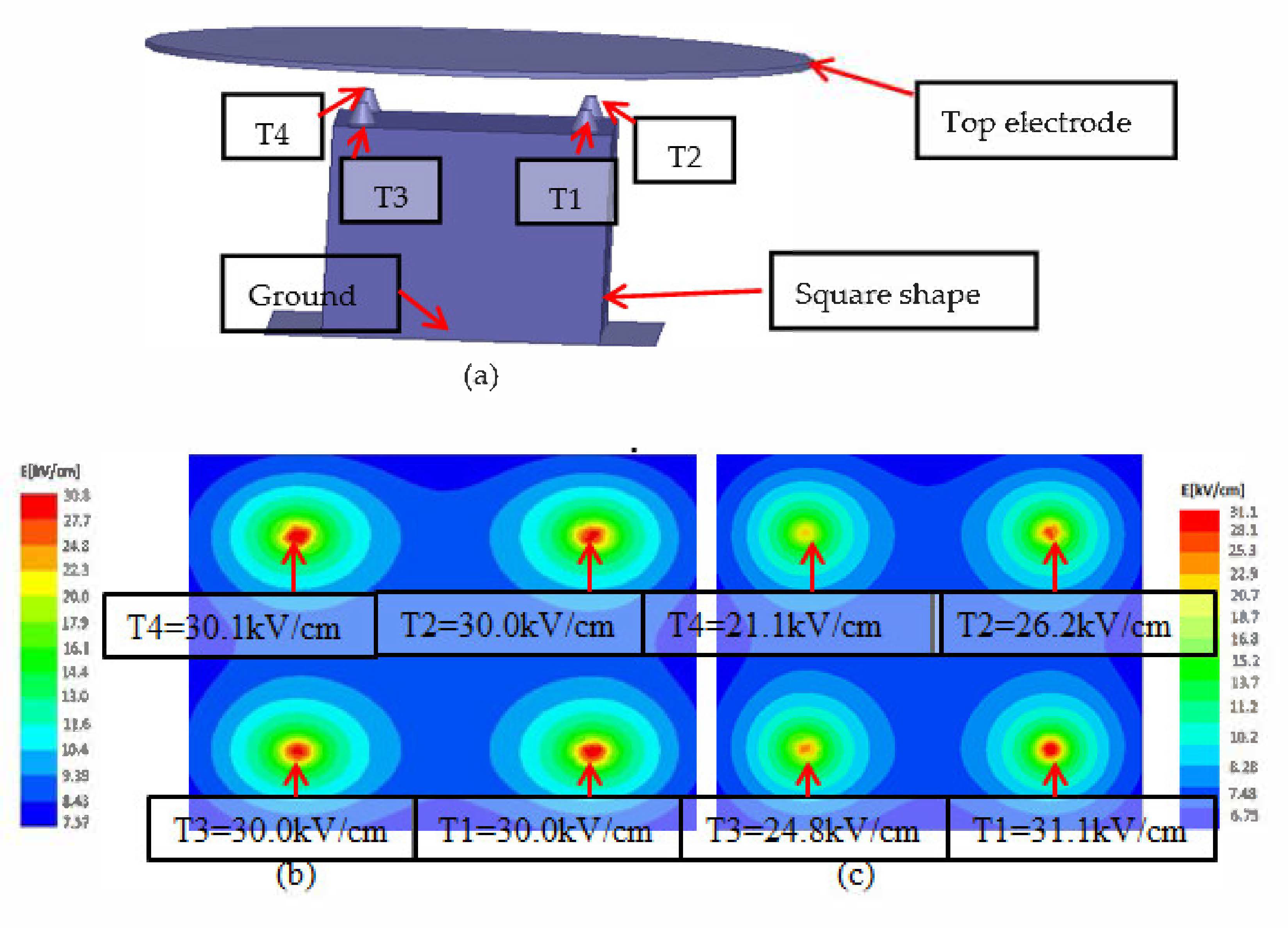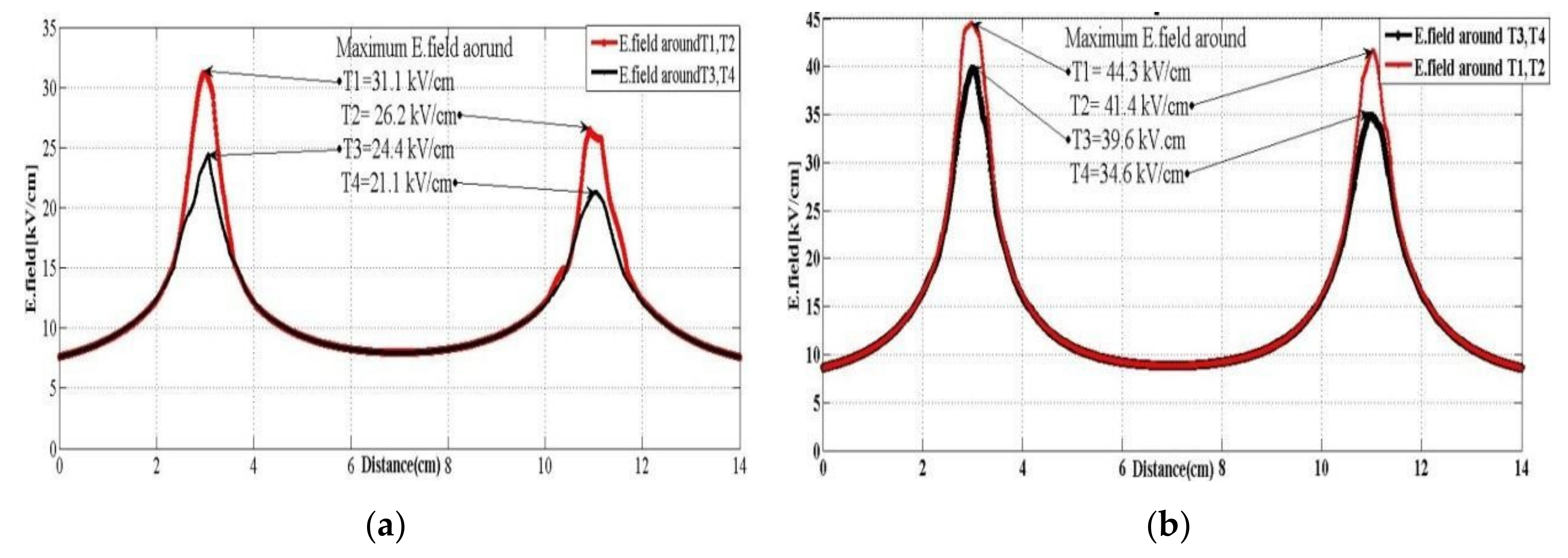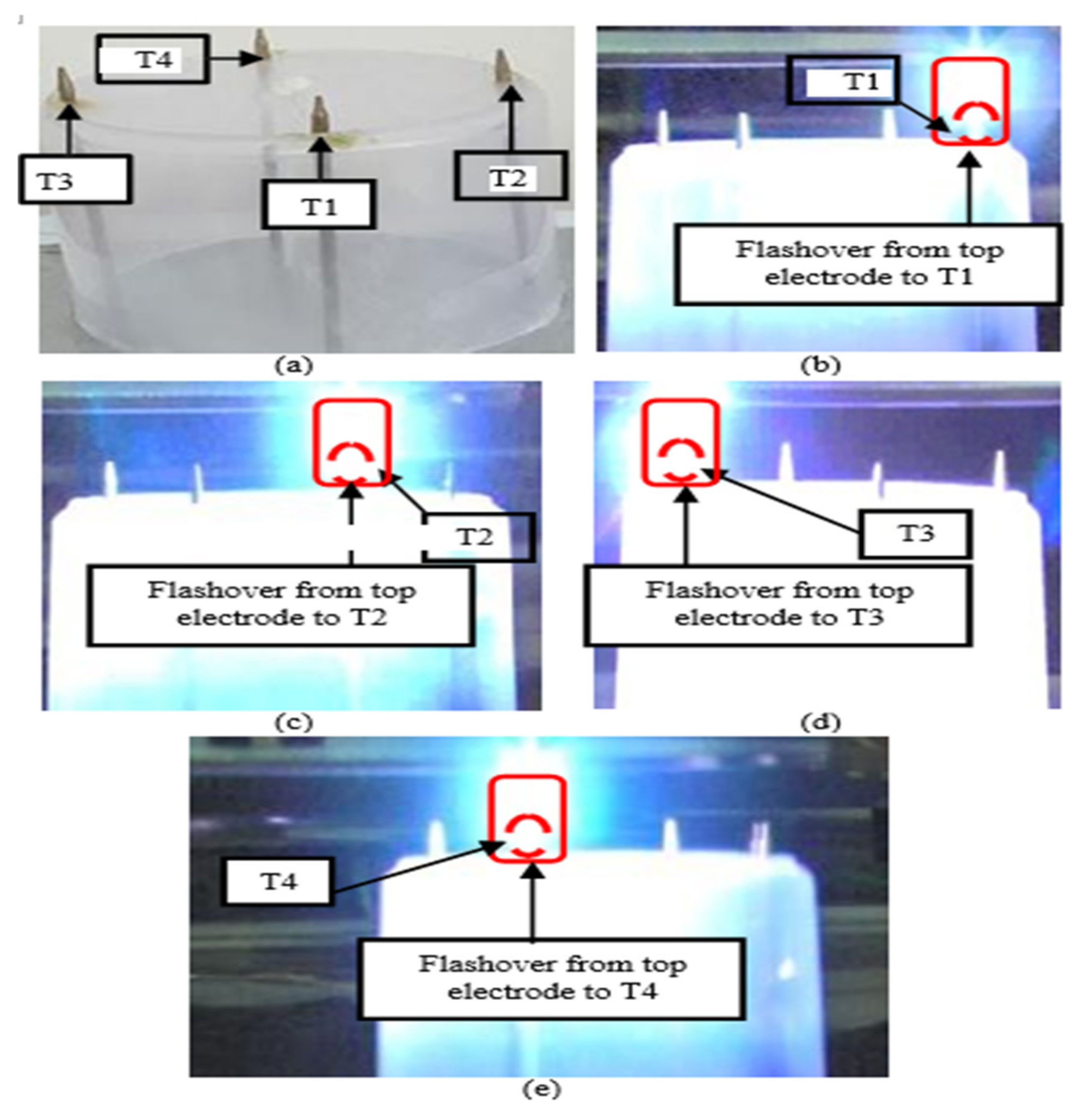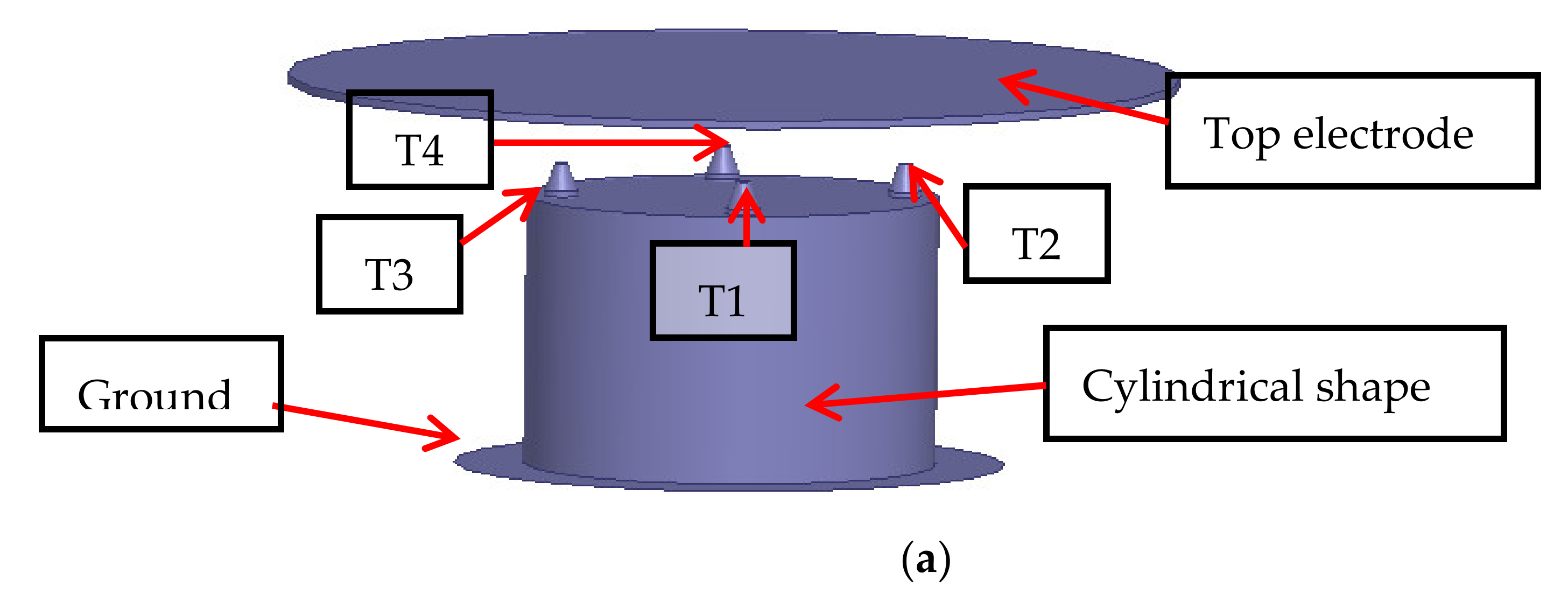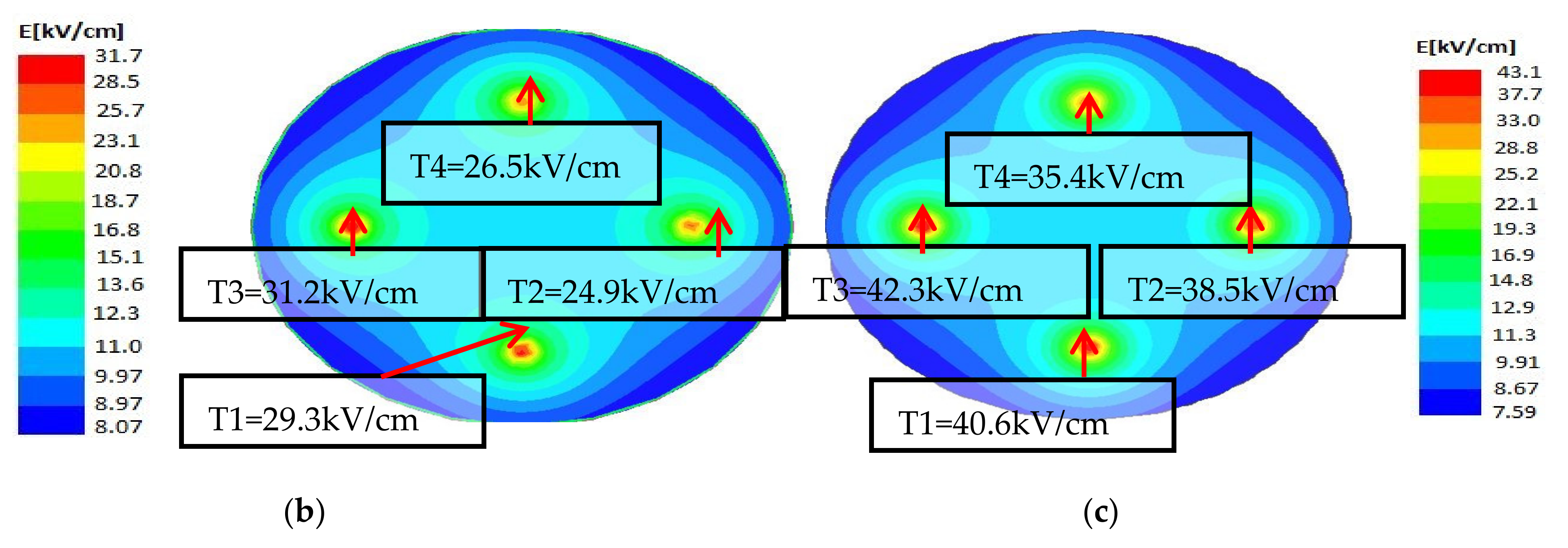Figure 1.
Schematic diagram of the experimental work.
Figure 1.
Schematic diagram of the experimental work.
Figure 2.
Electrification of grounded building structures with installed LAT during a thunderstorm; (a) matured cumulonimbus cloud, (b) cloud-to-ground electric field concentration, (c) mirror-image positive charges due to cloud base negative charges; the grounded structure is covered with positive charges, (d) electric field lines linking the ground and building with electric fields connected to the cloud.
Figure 2.
Electrification of grounded building structures with installed LAT during a thunderstorm; (a) matured cumulonimbus cloud, (b) cloud-to-ground electric field concentration, (c) mirror-image positive charges due to cloud base negative charges; the grounded structure is covered with positive charges, (d) electric field lines linking the ground and building with electric fields connected to the cloud.
Figure 3.
Electrification of grounded building structures with installed LAT during a thunderstorm (a) Upper part of the building with distribution of positive charges, (b) upper building sectionalized for electric field analysis, (c) electric field lines linking the ground and building with ground-to-cloud electric fields (symmetrical consideration), with upward and downward leaders involved.
Figure 3.
Electrification of grounded building structures with installed LAT during a thunderstorm (a) Upper part of the building with distribution of positive charges, (b) upper building sectionalized for electric field analysis, (c) electric field lines linking the ground and building with ground-to-cloud electric fields (symmetrical consideration), with upward and downward leaders involved.
Figure 4.
Lightning strike distribution on the Gable scaled model: (a) scaled gable shape (b) strike on LAT1, (c) strike on LAT2, (d) strike on LAT3.
Figure 4.
Lightning strike distribution on the Gable scaled model: (a) scaled gable shape (b) strike on LAT1, (c) strike on LAT2, (d) strike on LAT3.
Figure 5.
Probability of lightning strikes on a gable-shape scaled model: (a) 3D scaled gable shape, (b) electric field plot without upward leaders, (c) electric field plot with upward leaders.
Figure 5.
Probability of lightning strikes on a gable-shape scaled model: (a) 3D scaled gable shape, (b) electric field plot without upward leaders, (c) electric field plot with upward leaders.
Figure 6.
Electric field distribution with (a) and without upward leader inception (b).
Figure 6.
Electric field distribution with (a) and without upward leader inception (b).
Figure 7.
Lightning strike distribution on an L-shape scaled model: (a) scaled L-shape model, (b) strike on LAT1, (c) strike on LAT2, (d) strike on LAT3.
Figure 7.
Lightning strike distribution on an L-shape scaled model: (a) scaled L-shape model, (b) strike on LAT1, (c) strike on LAT2, (d) strike on LAT3.
Figure 8.
3-D model-Shape building structure (a) Probability of lightning on an L-shape structure: (b) field plot without upward leaders, (c) field plot with upward leaders.
Figure 8.
3-D model-Shape building structure (a) Probability of lightning on an L-shape structure: (b) field plot without upward leaders, (c) field plot with upward leaders.
Figure 9.
Electric field plot on an L-shape geometrical structure with and without upward leaders’ inception.
Figure 9.
Electric field plot on an L-shape geometrical structure with and without upward leaders’ inception.
Figure 10.
Lightning strike distribution on a square-shape model: (a) scaled square shape, (b) strike on LAT1, (c) strike on LAT2, (d) strike on LAT3, (e) strike on LAT4.
Figure 10.
Lightning strike distribution on a square-shape model: (a) scaled square shape, (b) strike on LAT1, (c) strike on LAT2, (d) strike on LAT3, (e) strike on LAT4.
Figure 11.
Probability of lightning on a square shape model: (a) square shape, (b) field plot without upward leaders, (c) field plot with upward leaders.
Figure 11.
Probability of lightning on a square shape model: (a) square shape, (b) field plot without upward leaders, (c) field plot with upward leaders.
Figure 12.
Electric field plot on an Square-shape geometrical structure with upward leader (a) and without upward leaders’ inception (b).
Figure 12.
Electric field plot on an Square-shape geometrical structure with upward leader (a) and without upward leaders’ inception (b).
Figure 13.
Lightning strike distribution on a cylindrical model: (a) scaled cylindrical shape, (b) strike on LAT1, (c) strike on LAT2, (d) strike on LAT3, (e) strike on LAT4.
Figure 13.
Lightning strike distribution on a cylindrical model: (a) scaled cylindrical shape, (b) strike on LAT1, (c) strike on LAT2, (d) strike on LAT3, (e) strike on LAT4.
Figure 14.
Probability of lightning on a cylindrical model: (a) circular shape, (b) field plot without upward leaders, (c) field plot with upward leaders.
Figure 14.
Probability of lightning on a cylindrical model: (a) circular shape, (b) field plot without upward leaders, (c) field plot with upward leaders.
Figure 15.
Probability of lightning strike on different points of a cylindrical structure (a) field value for normal pre-breakdown conditions, (b) field value for upward leader inception.
Figure 15.
Probability of lightning strike on different points of a cylindrical structure (a) field value for normal pre-breakdown conditions, (b) field value for upward leader inception.
Figure 16.
Lightning strike distribution on a pyramid-shape model: (a) scaled pyramid shape, (b) flashover on LAT1.
Figure 16.
Lightning strike distribution on a pyramid-shape model: (a) scaled pyramid shape, (b) flashover on LAT1.
Figure 17.
Probability of lightning on a pyramid-shape model: (a) 3D model of a pyramid shape (b) field plot without upward leaders, (c) field plot with upward leaders.
Figure 17.
Probability of lightning on a pyramid-shape model: (a) 3D model of a pyramid shape (b) field plot without upward leaders, (c) field plot with upward leaders.
Figure 18.
Probability of lightning strike on different points in a pyramid shape (a) field value for normal pre-breakdown conditions, (b) field value for upward leader inception.
Figure 18.
Probability of lightning strike on different points in a pyramid shape (a) field value for normal pre-breakdown conditions, (b) field value for upward leader inception.
Table 1.
Number of strikes and electric field on LATs of a gable shape.
Table 1.
Number of strikes and electric field on LATs of a gable shape.
| Installed Air Terminals | T1 | T2 | T3 |
|---|
| Measured value of Lightning Strikes | 14 | 3 | 13 |
| Electric Field in normal conditions (kV/cm) | 30.9 | 23.5 | 30.3 |
| Electric Field in the presence of upward leaders (kV/cm) | 36.8 | 30.1 | 35.1 |
Table 2.
Probability of lightning strikes on gable shape.
Table 2.
Probability of lightning strikes on gable shape.
| Installed Air Terminals | T1 | T2 | T3 |
|---|
| The number of Lightning Strikes | 14 | 3 | 13 |
| Electric field in normal condition (kV/cm) | 30.9 | 23.5 | 30.3 |
| Probability of strikes without upward leaders | 11 | 2 | 11 |
| Electric field in the presence of upward leaders (kV/cm) | 36.8 | 30.1 | 35.1 |
| Probability of strikes with upward leaders | 14 | 2 | 12 |
Table 3.
Number of strikes and electric field on the LATs of an L-shape building.
Table 3.
Number of strikes and electric field on the LATs of an L-shape building.
| Installed Air Terminals | T1 | T2 | T3 |
|---|
| Number of Lightning Strikes | 9 | 11 | 10 |
| Electric field in normal conditions (kV/cm) | 24.7 | 30.0 | 26.5 |
| Electric Field in the presence of upward leaders (kV/cm) | 35.5 | 42.2 | 40.2 |
Table 4.
Probability of lightning strikes on an L-shape building.
Table 4.
Probability of lightning strikes on an L-shape building.
| Installed Air Terminals | T1 | T2 | T3 |
|---|
| Number of lightning strikes | 9 | 11 | 10 |
| Electric Field in normal conditions (kV/cm) | 24.7 | 30.0 | 26.5 |
| Probability of strikes without upward leaders | 5 | 8 | 6 |
| Electric field with the introduction of upward leaders (kV/cm) | 39.5 | 42.4 | 40.2 |
| Probability of strikes with upward leaders | 8 | 11 | 9 |
Table 5.
Number of strikes and electric field on the LATs of a square-shape building.
Table 5.
Number of strikes and electric field on the LATs of a square-shape building.
| Installed Air Terminals | T1 | T2 | T3 | T4 |
|---|
| Number of lightning strikes | 10 | 8 | 7 | 5 |
| Electric field in normal condition (kV/cm) | 31.1 | 26.2 | 24.1 | 24.1 |
| Electric field with the introduction of upward leaders (kV/cm) | 44.4 | 41.3 | 39.6 | 34.6 |
Table 6.
Probability of lightning strikes on a square-shape building.
Table 6.
Probability of lightning strikes on a square-shape building.
| Installed Air Terminals | T1 | T2 | T3 | T4 |
|---|
| Number of lightning strikes | 10 | 8 | 7 | 5 |
| Electric field in normal condition (kV/cm) | 31.1 | 26.2 | 24.1 | 21.4 |
| Probability of strikes without upward leaders | 7 | 4 | 4 | 2 |
| Electric field with the introduction of upward leaders (kV/cm) | 44.4 | 41.3 | 39.6 | 34.6 |
| Probability of strikes with upward leaders | 10 | 7 | 6 | 4 |
Table 7.
Number of strikes and electric field on the LATs of a cylindrical building.
Table 7.
Number of strikes and electric field on the LATs of a cylindrical building.
| Installed Air Terminals | T1 | T2 | T3 | T4 |
|---|
| Number of lightning strikes | 8 | 7 | 9 | 6 |
| Electric field in normal conditions (kV/cm) | 29.3 | 24.9 | 31.2 | 26.5 |
| Electric field with the introduction of upward leaders (kV/cm) | 44.4 | 41.3 | 39.6 | 34.6 |
Table 8.
Probability of lightning strikes on a cylindrical building.
Table 8.
Probability of lightning strikes on a cylindrical building.
| Installed Air Terminals | T1 | T2 | T3 | T4 |
|---|
| Number of lightning strikes | 8 | 7 | 9 | 6 |
| Electric field in normal condition (kV/cm) | 29.3 | 24.9 | 31.2 | 26.5 |
| Probability of strikes without upward leaders | 6 | 4 | 7 | 4 |
| Electric field with the introduction of upward leaders (kV/cm) | 40.6 | 38.5 | 42.3 | 35.4 |
| Probability of strikes with upward leaders | 8 | 6 | 9 | 5 |
Table 9.
Number of strikes and electric field on a pyramid-shape building.
Table 9.
Number of strikes and electric field on a pyramid-shape building.
| Installed Air Terminals | T1 | T2–T5 |
|---|
| Number of lightning strikes | 30.0 | NIL |
| Electric field in normal conditions (kV/cm) | 28.5 | |
| Electric field with the introduction of upward leaders (kV/cm) | 44.0 | |
Table 10.
Probability of lightning strikes on a pyramid-shape building.
Table 10.
Probability of lightning strikes on a pyramid-shape building.
| Installed Air Terminals | T1 | T2–T5 |
|---|
| Number of lightning strikes | 30.0 | NIL |
| Electric Field in normal conditions (kV/cm) | 28.5 | |
| Probability of strikes without upward leaders | 19 | NIL |
| Electric field with the introduction of upward leaders (kV/cm) | 44.0 | |
| Probability of strikes with upward leaders | 30 | |
